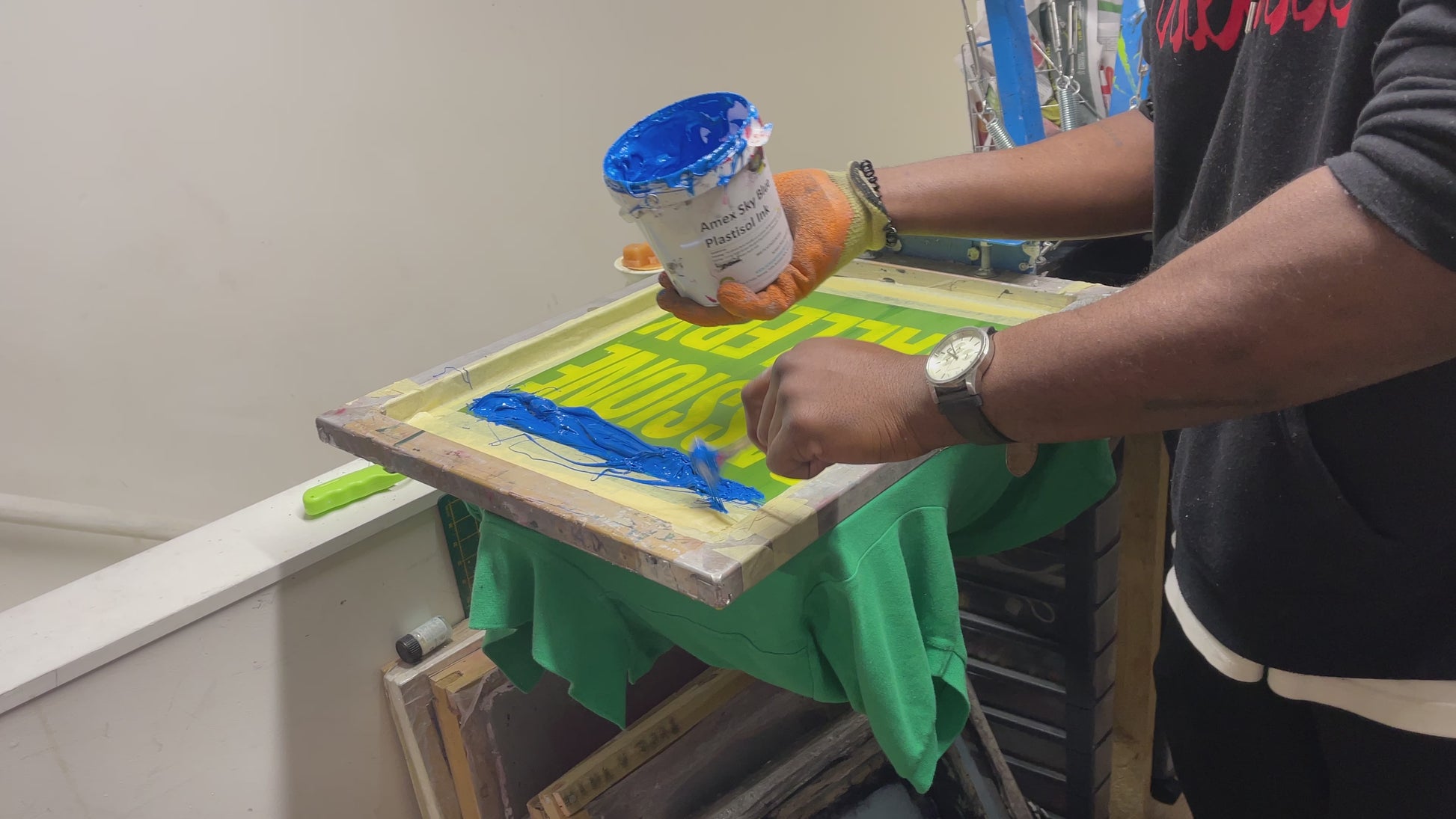Complete Screen Printing Kit for Artists and Creators
Display Printing Uncovered: Every Little Thing You Need to Find Out About T-Shirt and Garment Printing Methods
Screen printing is a fascinating approach that combines art with technique, offering countless opportunities for creativity. Ready to discover the essential components that make display publishing an art type?
The Essentials of Screen Printing: How It Functions
When you plunge into display printing, you'll find it's both a scientific research and an art. At its core, screen printing includes creating a pattern, or screen, that enables ink to pass with just in certain areas.
Following, you'll mix your inks and prepare your printing surface. Setting the display over the fabric, then use a squeegee to push ink via the screen onto the garment. This procedure needs accuracy, as you want clear, lively prints. After printing, you'll heal the ink with warmth, guaranteeing it follows the material and lasts via cleans. Each step is necessary, and mastering them will certainly raise your screen printing abilities, changing simple garments right into distinct, expressive items.
Kinds Of Display Printing Strategies
When you understand the essentials of display printing, it's time to discover the various techniques that can raise your designs. One prominent approach is conventional screen printing, where ink is pressed via a stenciled screen.
One more option is plastisol printing, understood for its durability and vivid shades, making it a favorite for several brand names. Experiment with halftone printing to develop gradient effects and detailed styles.
Important Devices for Screen Printing
To accomplish magnificent outcomes in display printing, having the best tools is essential. You'll require a sturdy screen printing framework, which holds the mesh that moves your style onto the garment. Next off, spend in top notch mops; these are important for applying ink evenly throughout the display.
Selecting the Right Inks and Materials
When choosing inks and materials for screen printing, you need to take into account the sort of ink that functions finest for your task. Consider material compatibility to assure your layouts look great and last lengthy. Additionally, explore green ink alternatives to make your printing process more sustainable.
Kinds of Display Inks
Picking the right screen ink is crucial for accomplishing vivid, resilient prints that satisfy your job's demands. There are several types of display inks to take a look at. Specialized inks, such as metallic or glow-in-the-dark, can include special impacts to your designs.

Fabric Compatibility Factors To Consider
Recognizing textile compatibility is vital for attaining top notch screen prints, especially because various materials respond distinctly to various inks. Always check your inks on example fabric to assure they adhere effectively and maintain shade integrity. In addition, keep in mind that textile weight and texture can impact the final end result, so selecting the ideal ink and product combo is vital for your project's success.
Eco-Friendly Ink Options
Green inks are becoming a popular choice for screen printers that desire to decrease their environmental impact while maintaining top quality. When choosing inks, consider water-based inks, which are less damaging and less complicated to clean up compared to typical solvents.
In addition, seek inks made from eco-friendly sources, such as soy or vegetable-based choices. By choosing the appropriate inks and materials, you'll not just produce spectacular layouts but also add to a more lasting printing procedure. Make the button, and your prints will show your commitment to the environment!
Preparing Your Style for Screen Printing

Submit Layout Demands
To guarantee your layout looks vivid and sharp on textile, you'll require to pay close focus to file style demands for screen printing. Make sure your layout has a transparent history to stop undesirable white sides on your prints. Maintain color modes in mind; CMYK is standard for display printing, so convert your RGB designs accordingly.
Color Splitting Up Techniques
Color splitting up is a necessary action in preparing your design for screen printing, and grasping it can greatly enhance your print top quality. You'll require to break your layout into specific colors, as each shade needs a separate display throughout printing. This precision not just ensures accurate color depiction but additionally enhances the printing process.
Resolution and Dimension
Achieving the very best results in screen printing starts with ensuring your layout has the best resolution and dimension. Preferably, your artwork must go to the very least 300 DPI (dots per inch) for sharp, clear prints. Your last item might look amateur and pixelated. if you use lower resolution.
When it comes to size, take into consideration the dimensions of your print area. Style your art work to match the final print size, ideally producing it in the real dimensions you'll be publishing. This way, you'll avoid any kind of unexpected scaling concerns.
Constantly check your design in both vector and raster styles. Vector graphics can be scaled without losing top quality, making them excellent for display printing. Preparing correctly will guarantee your design looks amazing on every garment!
Step-by-Step Display Printing Process
Screen printing is a dynamic procedure that enables you to produce dynamic designs on various surfaces. To get started, her comment is here you'll require a display, emulsion, and your picked ink.
After rinsing the unexposed solution, your screen is ready. Set it up on your printing surface area and straighten your garment under it. Put ink onto the display and utilize a squeegee to push the ink with the stencil onto the textile. Lift the screen meticulously and allow the print completely dry. Treat the ink using warmth to guarantee resilience. That's it! You've successfully display printed your layout.
Tips for Successful Display Printing Projects
While you're diving into your display printing projects, keep in mind that preparation is crucial to success. Beginning by collecting all your products-- inks, garments, squeegees, and displays. A tidy office helps stop unwanted errors, so clean before you begin.
Following, verify your art work is high-resolution and properly sized for your garment. Evaluate your screen for appropriate direct exposure and clean it thoroughly to stay clear of smudges. When blending your inks, adhere to the maker's standards to attain the best consistency.
During printing, use also stress with your squeegee for consistent results. Do not hurry; take your time to confirm each print satisfies your standards. After printing, allow your garments dry totally before taking care of or packaging them.
Lastly, always keep an example of your help future reference. By doing this, you can analyze your progression and enhance your methods over time. Happy printing!

Regularly Asked Inquiries
Exactly how Long Does It Take to Establish a Screen Printing Job?
Establishing up a display printing task commonly takes around 30 mins to an hour. You'll prepare the displays, mix inks, and change the press. The time varies based on intricacy and experience, so remain organized!
Can I Print on Various Fabric Types Using the Same Strategy?
Yes, you can publish on various textile kinds utilizing the same strategy, however you'll require to readjust your settings and inks. Some textiles take in ink in a different way, so experimenting guarantees the very best outcomes for every material.
What Prevail Errors to Avoid in Display Printing?
When screen printing, stay clear of usual blunders like using the incorrect ink, ignoring proper direct exposure times, or avoiding pre-press checks. Always examine your configuration and maintain clean displays to assure high quality outcomes each time.
Exactly How Can I Effectively Clean and Preserve My Display Printing Equipment?
To appropriately clean and keep your display printing devices, you need to frequently wash displays with suitable solvents, inspect mops for wear, and assure all devices are stored dry and dust-free. Uniformity check that boosts and prevents costly fixings performance.
Is Display Printing Eco-friendly Contrasted to Various Other Approaches?
Screen printing can be a lot more environmentally friendly than other techniques, specifically if you use water-based inks and eco-conscious products. By choosing lasting materials and page methods, you lower waste and minimize your effect on the world.
Screen Printing Uncovered: Every Little Thing You Required to Know About T-Shirt and Garment Printing Methods
At its core, screen printing includes developing a stencil, or screen, that allows ink to pass through just in particular areas. Setting the display over the textile, then use a squeegee to push ink through the screen onto the garment. One prominent approach is conventional display printing, where ink is pressed via a stenciled display.When selecting inks and products for display printing, you need to take right into account the type of ink that works best for your job.